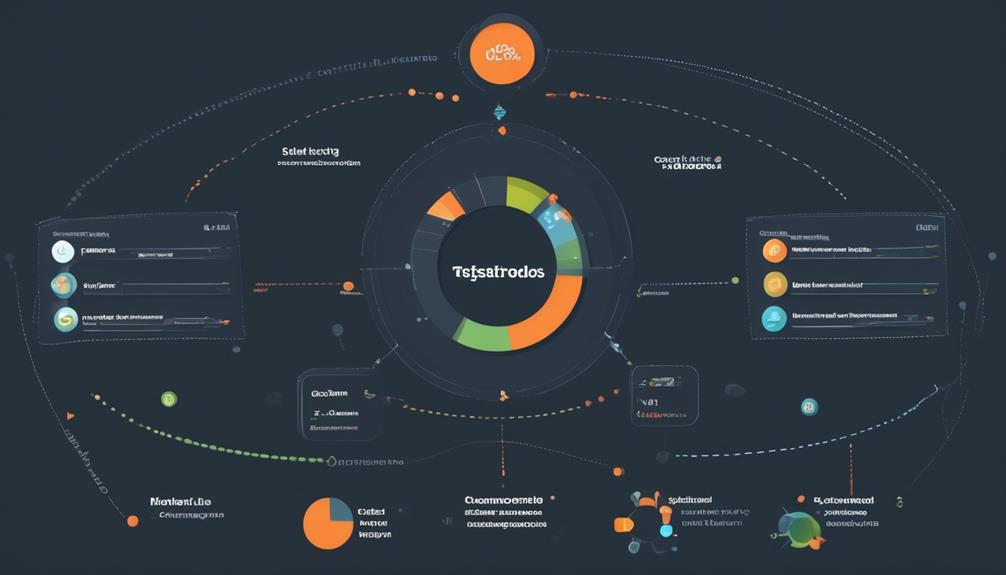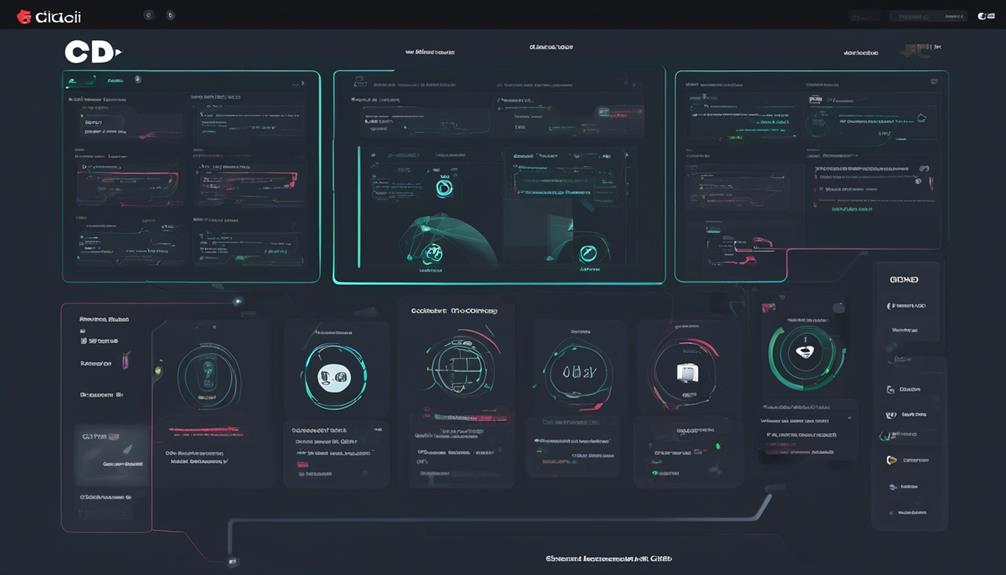Are you confident that you have found the best tool for continuous integration testing? Brace yourself as we are about to unveil the top contenders in this industry.
With a plethora of options available, it can be quite the conundrum to choose the right one for your needs. But fear not, as we’re about to break down the most popular continuous integration testing tools and highlight their key features.
Stick around to discover which tool might just be the game-changer for your development process.
Key Takeaways
- Version control is a crucial pillar of continuous integration to ensure collaboration and conflict-free codebase.
- Automated testing is essential for verifying code correctness and preventing regressions.
- Build automation with CI tools streamlines the build process, contributing to efficient software development.
- When selecting a CI tool, it is important to evaluate factors such as ecosystem, cloud compatibility, deployment options, integration capabilities, and security features.
Pillars of Continuous Integration
In understanding the pillars of Continuous Integration, it becomes clear that they’re foundational elements that underpin the seamless and efficient software development process. Continuous Integration (CI) is an essential practice in modern software development, integrating various pillars such as version control, automated testing, build automation, and automated deployments.
Version control, a fundamental pillar of CI, ensures that multiple developers can work on the same codebase without conflicts. Popular tools like Git and Subversion provide robust version control management, enabling seamless collaboration.
Automated testing, another crucial pillar, involves running test suites to verify the correctness of the code, preventing regressions and ensuring the production of bug-free software.
Build automation is also integral, as it involves creating artifacts to capture the current release version, streamlining the build process with the aid of CI tools.
These pillars collectively contribute to the efficiency and reliability of software development by enabling automation, version control, and seamless integration across development, testing, and deployment stages.
Understanding and mastering these pillars are essential for any development team seeking to excel in the CI/CD (Continuous Integration/Continuous Deployment) platform.
Continuous Integration Tools Comparison

Comparing and evaluating continuous integration tools involves meticulous consideration of their features, functionalities, and compatibility with the development environment. When examining these tools, it’s crucial to assess their capabilities in areas such as build management, version control integration, automated testing, and deployment within the CI/CD process.
Below is a comparison of a few popular continuous integration tools:
- Jenkins: Offers deep workflow customization, a rich set of features and plugins, and is an open-source CI tool.
- TeamCity: Allows importing source code from different version control systems into a single build, supports concurrent builds, and is free for up to 100 build configurations.
- Bamboo: Integrates effortlessly with other Atlassian tools, provides a user-friendly UI with drag-and-drop functionality, and allows test automation with the help of elastic agents.
Each of these tools brings unique strengths to the table, and the choice of the most suitable tool depends on the specific needs of the development team. Whether it’s the need for open-source flexibility, concurrent build support, or seamless integration with other tools, careful consideration of these aspects is crucial in selecting the right continuous integration tool for a project.
Best CI Tool Selection Criteria
Careful evaluation of the robust ecosystem, cloud compatibility, deployment options, integration capabilities, and security features is essential when selecting the best continuous integration tool for a project.
A robust ecosystem ensures that the CI tool supports various development needs and workflows effectively.
Cloud compatibility is crucial for easy scalability and accessibility, allowing seamless integration into the software development process.
Flexible deployment options accommodate different project needs and environments, enabling continuous integration and delivery.
Integration capabilities with version control, CI/CD platforms, and other tools are essential for seamless workflow management and automation.
Additionally, safety and security features are paramount for protecting sensitive project data and ensuring compliance with industry standards.
When choosing the best continuous integration tools, it’s imperative to consider these criteria to facilitate continuous deployment and streamline the overall CI/CD solution.
The thorough consideration of these factors is vital for selecting a CI/CD platform that aligns with the DevOps automation needs and optimizes the software development process.
Recommended CI/CD Tools

Evaluating the robust ecosystem, cloud compatibility, deployment options, integration capabilities, and security features of various continuous integration tools has led us to recommend a selection of top CI/CD tools for consideration.
When exploring the realm of recommended CI/CD tools, several stand out for their robust features and flexibility:
- Bitbucket Pipelines: This tool seamlessly integrates with Bitbucket and provides a user-friendly interface for setting up CI/CD pipelines. It supports parallel test execution and can be easily customized to suit the needs of different teams.
- CircleCI: Known for its scalability and speed, CircleCI offers a robust platform for build automation and deployment. It supports version control systems like GitHub and Bitbucket, making it an ideal choice for teams working with distributed repositories.
- GitLab CI: As part of the GitLab DevOps Platform, GitLab CI provides a powerful open-source solution for continuous integration. It offers seamless integration with GitLab’s version control system and comes with a variety of features for automated testing and deployment.
These tools offer varying features, including paid plans for additional benefits, making them suitable for teams with diverse requirements in their CI/CD pipelines.
How to Choose a CI/CD Software
When selecting a CI/CD software, it’s essential to carefully consider its compatibility with version control systems, programming languages, and testing frameworks. The best CI tool offers seamless integration and continuous delivery, allowing for efficient automation of the CI/CD pipeline.
It’s crucial to assess the flexibility, customization, and workflow integration options offered by different CI/CD software tools. Additionally, evaluating the robust ecosystem, cloud compatibility, deployment options, integration possibilities, and safety features is imperative.
The ease of use, customization options, features, plugins, and deployment capabilities should also be thoroughly examined. Furthermore, it’s essential to consider whether an open-source or a commercial CI/CD software aligns better with the organization’s needs.
When choosing a CI/CD software, benefits such as automation, rapid feedback, language and framework support, performance, and integrations should be taken into account. By carefully analyzing these factors, one can make an informed decision and select a CI/CD software that best suits the organization’s requirements for seamless integration and continuous delivery.
Frequently Asked Questions
What Is the Most Used CI Tool?
The most used CI tool is Jenkins, known for its deep workflow customization and robust ecosystem of features and plugins.
It offers extensive flexibility in automating the software development process.
Jenkins stands out as a popular choice due to its widespread adoption and extensive community support.
Its versatility and scalability make it a top choice for organizations seeking effective continuous integration.
Which of the Tools Are Used for Continuous Integration?
For continuous integration, we use the following tools:
- Jenkins: It provides deep workflow customization.
- TeamCity: It allows testing changes without committing them to the VCS.
- Bamboo: It integrates effortlessly with other Atlassian tools.
- Buddy: It offers an instinctive UI and advanced automation.
- GitLab CI: It supports Docker and runs parallel builds across multiple machines.
Is Jira a CI CD Tool?
No, Jira isn’t a CI/CD tool.
However, it can integrate with CI/CD tools to manage project tasks. Its integrations allow for tracking and managing development, testing, and deployment workflows within the project management tool.
Using Jira alongside CI/CD tools provides comprehensive visibility and management of the entire software development process. Jira’s issue tracking, task management, and reporting capabilities complement CI/CD tool functionalities for efficient project management.
Which Is Best CI CD Pipeline?
When evaluating the best CI/CD pipeline, we consider factors like scalability, integrations, user-friendliness, and automation capabilities.
A robust pipeline should seamlessly handle the entire software development lifecycle, from building and testing to deployment.
Our analysis focuses on efficient resource utilization, support for diverse technologies, and comprehensive feedback mechanisms.
We prioritize a solution that fosters continuous improvement and aligns with our organizational goals, ensuring smooth and reliable software delivery.
Conclusion
In conclusion, when it comes to choosing the top continuous integration testing tools, it’s important to carefully consider the specific needs of your development team and project.
Just like a craftsman carefully selects the right tool for the job, selecting the best CI/CD software requires attention to detail, methodical research, and analytical thinking.
By taking the time to evaluate the features, integrations, and capabilities of each tool, you can ensure a seamless and efficient continuous integration process for your projects.
Randy serves as our Software Quality Assurance Expert, bringing to the table a rich tapestry of industry experiences gathered over 15 years with various renowned tech companies. His deep understanding of the intricate aspects and the evolving challenges in SQA is unparalleled. At EarnQA, Randy’s contributions extend well beyond developing courses; he is a mentor to students and a leader of webinars, sharing valuable insights and hands-on experiences that greatly enhance our educational programs.









